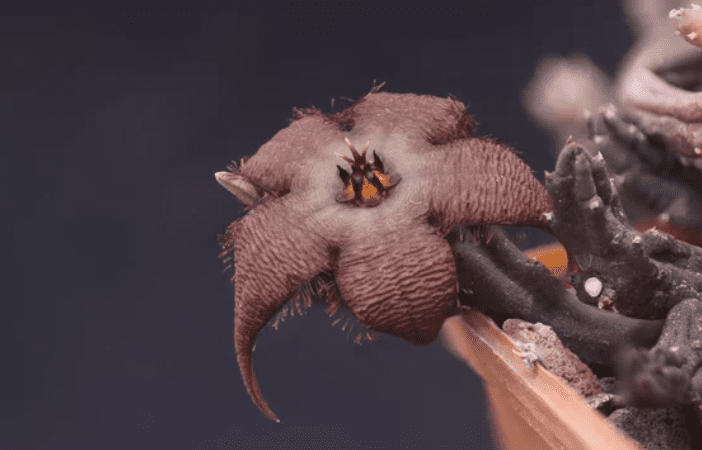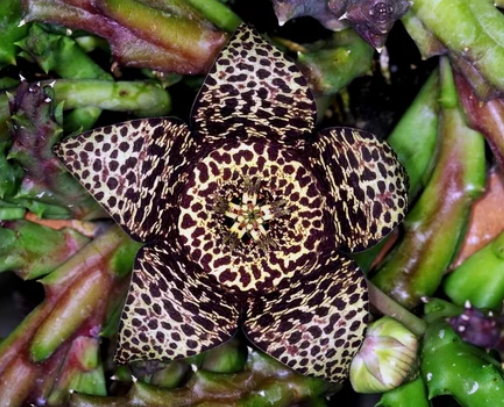
When I first laid eyes on a Stapelia, it was like stumbling upon a secret garden in the heart of South Africa. With their unique hairy flowers and distinct pungent odor, these succulent houseplants, also known as carrion flowers, are a marvel of the natural world.
One could say that Stapelias bask in the limelight, thriving under bright lights. They have a penchant for well-drained soil and bask in the warmth like a sunbather on a golden beach.
Water, on the other hand, they take in sips rather than gulps, making them perfect companions even for those without green fingers. But beware, for when the mercury dips below 50°F, these beauties turn into delicate princesses and must be whisked indoors, away from the cold’s cruel grasp.
Much like how a castle can be overrun with dragons and trolls, Stapelias, too, face their fair share of foes. Overwatering is akin to opening the floodgates to root rot and fungal attacks. And let’s not forget the crafty mealybugs that are ever so eager to make a meal out of them. And although the flowers can often be a fly’s equivalent of a siren’s song, their aroma might make your nose turn up in protest.
But fear not, for propagating Stapelias is as easy as pie. Division and cuttings are your weapons of choice in this garden quest. Let the cuttings dry and callous, like a warrior letting his wounds heal before planting them. Although a rarity in cultivation, seeds can be sown on a damp sand and soil mix battlefield.
There’s no denying the charisma of these beautiful carrion flowers. Zulu giant, giant toad plant, Orbea variegata, and Stapelia flavopurpurea are like round table knights, each with its unique armor of different flower colors, sizes, and fragrances.
So, if you’re looking for a plant that’s a true testament to the wonders of Mother Nature, look no further than the Stapelia. With their curious flowers, these hairy beauties will bring a touch of the wild South African plains into your living room. Just hold your nose and enjoy the show!
How to Grow Stapelia
Stapelias are not hardy outdoors in most parts of the United States. They can be placed outdoors or in the garden during the summer, but they must be brought indoors once the temperature drops below 50°F. They must also be protected from excess moisture, such as irrigation and rainfall, or they will not survive.
Here are some tips on how to care for stapelia indoors:
- Light: Stapelias need bright indoor light to thrive. You can place them near a south- or west-facing window or use a grow light. In nature, stapelias often grow under the shade of other plants, so they don’t need total sun exposure. Too much sun can cause the stems to turn red or purple, a sign of sunburn.
- Soil: Stapelias need gritty, well-drained, slightly alkaline soil. You can use a standard cactus potting mix and add perlite, gravel, or grit to improve drainage. Plant them in small, shallow terracotta pots that allow excess water to evaporate quickly. Don’t repot them too often, as they can live in the same container for many years.
- Water: Stapelias need very little water, especially in winter when they go dormant. Overwatering is the easiest way to kill them, as it can cause root rot and fungal infections. Water them only when the soil is arid, and reduce watering frequency in autumn and winter. It is expected to go three to four weeks without watering during dormancy. If in doubt, don’t water.
- Temperature: Stapelias prefer warm temperatures between 70°F and 95°F. They cannot tolerate cold or frost, so keep them indoors when the temperature is below 50°F. They can handle abrupt drops in temperature at night as long as they warm up during the day.
- Fertilizer: Stapelias need little fertilizer, as they are adapted to low-nutrient environments. However, you can apply a half-strength solution of low-nitrogen fertilizer (such as cactus fertilizer) once or twice during the growing season (spring and summer). Don’t fertilize them in autumn or winter.
- Pruning: Stapelias don’t need much pruning except to remove dead, diseased, or dying stems. You can also prune them to make cuttings for propagation (see below). Use a clean, sharp knife or pruner to make the cuts, and wear gloves to avoid touching the milky sap from the wounds. The sap can irritate some people’s skin.

How to Propagate Stapelia
Division or cuttings usually propagate stapelias. Plants in cultivation rarely produce seeds.
Here are the steps for each method:
- Division: You can divide stapelia plants early in the growing season (spring or summer) by separating rooted sections from the main plant. Use a sharp knife or pruner to make clean cuts and avoid damaging the roots. Repot the divisions immediately into small pots with well-draining soil. Water them lightly and grow them as usual.
- Cuttings: You can also propagate stapelia by taking stem cuttings during the warm growing season (spring or summer). Cut healthy stems about 3 to 6 inches long with a sharp knife or pruner. Let the cut ends dry and callous for a few days or weeks in a shady place with good airflow.
Once the cut ends have healed, place them horizontally on moistened soil in a shallow tray or pot. Don’t bury them in the soil, as they may rot. Please keep them in a warm place with bright indirect light and mist them lightly every few days. Roots should form along the sides of the stems in a few weeks or months. Once the roots are established, you can transplant the cuttings into individual pots and grow them as usual.
Popular Stapelia Species
There are more than 40 species of stapelia, but only a few are commonly grown as houseplants. Here are some of the most popular ones:
- Zulu giant (Stapelia gigantea): This is one of the largest and most impressive stapelia species, with velvety green stems up to 1.25 inches thick and cream-colored flowers with red stripes up to 10 inches across. The flowers have a strong odor of rotting meat, which attracts flies for pollination28. You can hear them make a sound when they open, like tearing paper. This species is easy to grow and can tolerate some neglect.
- Giant toad plant (Stapelia grandiflora): This is another large stapelia species, similar in size to the Zulu giant. It has hairy red flowers that vary from light to dark maroon. The stems are green and up to 12 inches long. The flowers also smell like carrion and attract flies.
- Orbea variegata: This is a small, dainty stapelia species with yellow flowers speckled with chocolate brown spots. The flowers are about 2 to 3 inches wide and the stems are about 4 inches tall. They often sell it as Stapelia variegata, although the correct name is now Orbea variegata. This species is perfect for growing in small containers.
- Stapelia flavopurpurea: This is a rare and beautiful stapelia species with greenish-yellow flowers that have pink centers. The flowers are about 2 inches wide and have a sweet and pleasant fragrance. The stems are about 4 to 6 inches tall and wide. This species is hard to find in cultivation but worth looking for if you want a stapelia that smells good.
Conclusion
Stapelias are unique and collectible succulent houseplants that will amaze you with their otherworldly flowers. They are easy to grow and propagate as long as you provide them with bright light, well-drained soil, warm temperatures, and little water. They also come in various sizes, colors, and shapes, so you can choose the ones that suit your taste and space.

























